torque YAMAHA XV1600A 2001 Owners Manual
[x] Cancel search | Manufacturer: YAMAHA, Model Year: 2001, Model line: XV1600A, Model: YAMAHA XV1600A 2001Pages: 104, PDF Size: 20.37 MB
Page 30 of 104
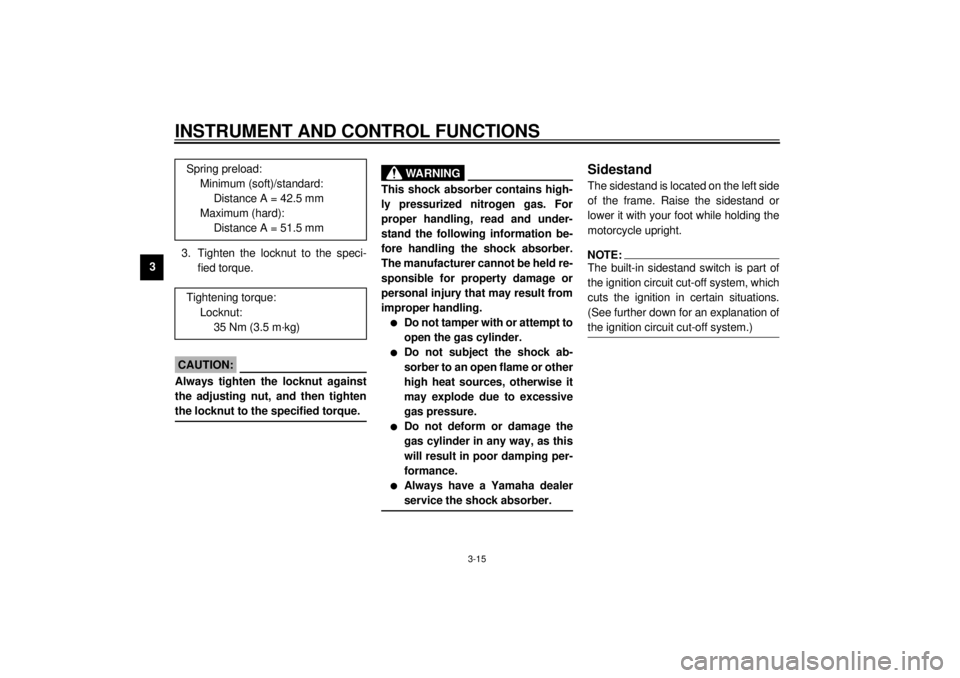
INSTRUMENT AND CONTROL FUNCTIONS
3-15
33. Tighten the locknut to the speci-
fied torque.
EC000018
CAUTION:@ Always tighten the locknut against
the adjusting nut, and then tighten
the locknut to the specified torque. @
EAU00315
WARNING
@ This shock absorber contains high-
ly pressurized nitrogen gas. For
proper handling, read and under-
stand the following information be-
fore handling the shock absorber.
The manufacturer cannot be held re-
sponsible for property damage or
personal injury that may result from
improper handling.l
Do not tamper with or attempt to
open the gas cylinder.
l
Do not subject the shock ab-
sorber to an open flame or other
high heat sources, otherwise it
may explode due to excessive
gas pressure.
l
Do not deform or damage the
gas cylinder in any way, as this
will result in poor damping per-
formance.
l
Always have a Yamaha dealer
service the shock absorber.
@
EAU00330
Sidestand The sidestand is located on the left side
of the frame. Raise the sidestand or
lower it with your foot while holding the
motorcycle upright.NOTE:@ The built-in sidestand switch is part of
the ignition circuit cut-off system, which
cuts the ignition in certain situations.
(See further down for an explanation of
the ignition circuit cut-off system.) @
Spring preload:
Minimum (soft)/standard:
Distance A = 42.5 mm
Maximum (hard):
Distance A = 51.5 mm
Tightening torque:
Locknut:
35 Nm (3.5 m·kg)
E_5JA.book Page 15 Wednesday, September 13, 2000 6:06 PM
Page 46 of 104

6-1
6
EAU00462
6-PERIODIC MAINTENANCE AND MINOR REPAIR
EAU00464
Safety is an obligation of the owner.
Periodic inspection, adjustment and lu-
brication will keep your vehicle in the
safest and most efficient condition pos-
sible. The most important points of in-
spection, adjustment, and lubrication
are explained on the following pages.
The intervals given in the periodic
maintenance and lubrication chart
should be simply considered as a gen-
eral guide under normal riding condi-
tions. However, DEPENDING ON THE
WEATHER, TERRAIN, GEOGRAPHI-
CAL LOCATION, AND INDIVIDUAL
USE, THE MAINTENANCE INTER-VALS MAY NEED TO BE SHORT-
ENED.
EW000060
WARNING
@ If you are not familiar with motor-
cycle maintenance work, have a
Yamaha dealer do it for you. @
EAU03394
Owner’s tool kit The owner’s tool kit is located under
the rider seat. (See page 3-12 for rider
seat removal and installation proce-
dures.)
The service information included in this
manual and the tools provided in the
owner’s tool kit are intended to assist
you in the performance of preventive
maintenance and minor repairs. How-
ever, additional tools such as a torque
wrench may be necessary to perform
certain maintenance work correctly.1. Owner’s tool kit
E_5JA.book Page 1 Wednesday, September 13, 2000 6:06 PM
Page 52 of 104

PERIODIC MAINTENANCE AND MINOR REPAIR
6-7
6
EAU01639
Checking the spark plugs The spark plugs are important engine
components, which should be checked
periodically, preferably by a Yamaha
dealer. Since heat and deposits will
cause any spark plug to slowly erode,
they should be removed and checked
in accordance with the periodic mainte-
nance and lubrication chart. In addition,
the condition of the spark plugs can re-
veal the condition of the engine.
The porcelain insulator around the cen-
ter electrode of each spark plug should
be a medium-to-light tan (the ideal col-
or when the motorcycle is ridden nor-
mally), and all spark plugs installed inthe engine should have the same color.
If any spark plug shows a distinctly dif-
ferent color, the engine could be defec-
tive. Do not attempt to diagnose such
problems yourself. Instead, have a
Yamaha dealer check the motorcycle.
If a spark plug shows signs of electrode
erosion and excessive carbon or other
deposits, it should be replaced.
Before installing a spark plug, the spark
plug gap should be measured with a
wire thickness gauge and, if necessary,
adjusted to specification.Clean the surface of the spark plug
gasket and its mating surface, and then
wipe off any grime from the spark plug
threads.
NOTE:@ If a torque wrench is not available when
installing a spark plug, a good estimate
of the correct torque is 1/4–1/2 turn
past finger tight. However, the spark
plug should be tightened to the speci-
fied torque as soon as possible. @
a. Spark plug gap
Specified spark plug:
DPR7EA-9/NGK or
X22EPR-U9/DENSO
Spark plug gap:
0.8–0.9 mm
Tightening torque:
Spark plug:
17.5 Nm (1.75 m·kg)
E_5JA.book Page 7 Wednesday, September 13, 2000 6:06 PM
Page 55 of 104
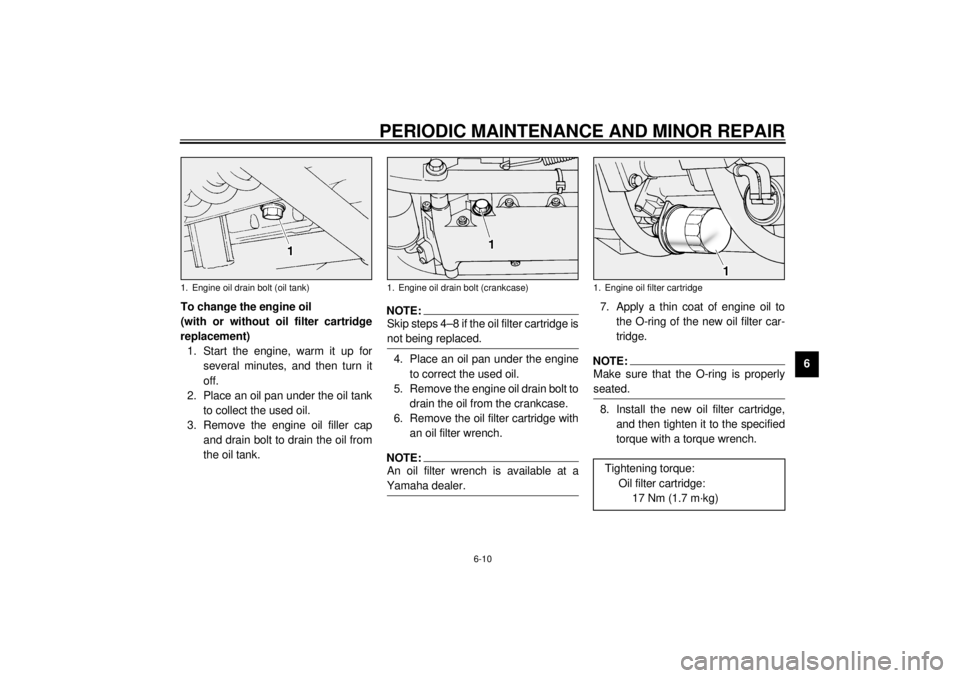
PERIODIC MAINTENANCE AND MINOR REPAIR
6-10
6 To change the engine oil
(with or without oil filter cartridge
replacement)
1. Start the engine, warm it up for
several minutes, and then turn it
off.
2. Place an oil pan under the oil tank
to collect the used oil.
3. Remove the engine oil filler cap
and drain bolt to drain the oil from
the oil tank.
NOTE:@ Skip steps 4–8 if the oil filter cartridge is
not being replaced. @4. Place an oil pan under the engine
to correct the used oil.
5. Remove the engine oil drain bolt to
drain the oil from the crankcase.
6. Remove the oil filter cartridge with
an oil filter wrench.NOTE:@ An oil filter wrench is available at a
Yamaha dealer. @
7. Apply a thin coat of engine oil to
the O-ring of the new oil filter car-
tridge.NOTE:@ Make sure that the O-ring is properly
seated. @8. Install the new oil filter cartridge,
and then tighten it to the specified
torque with a torque wrench.
1. Engine oil drain bolt (oil tank)
1. Engine oil drain bolt (crankcase)
1. Engine oil filter cartridgeTightening torque:
Oil filter cartridge:
17 Nm (1.7 m·kg)
E_5JA.book Page 10 Wednesday, September 13, 2000 6:06 PM
Page 56 of 104
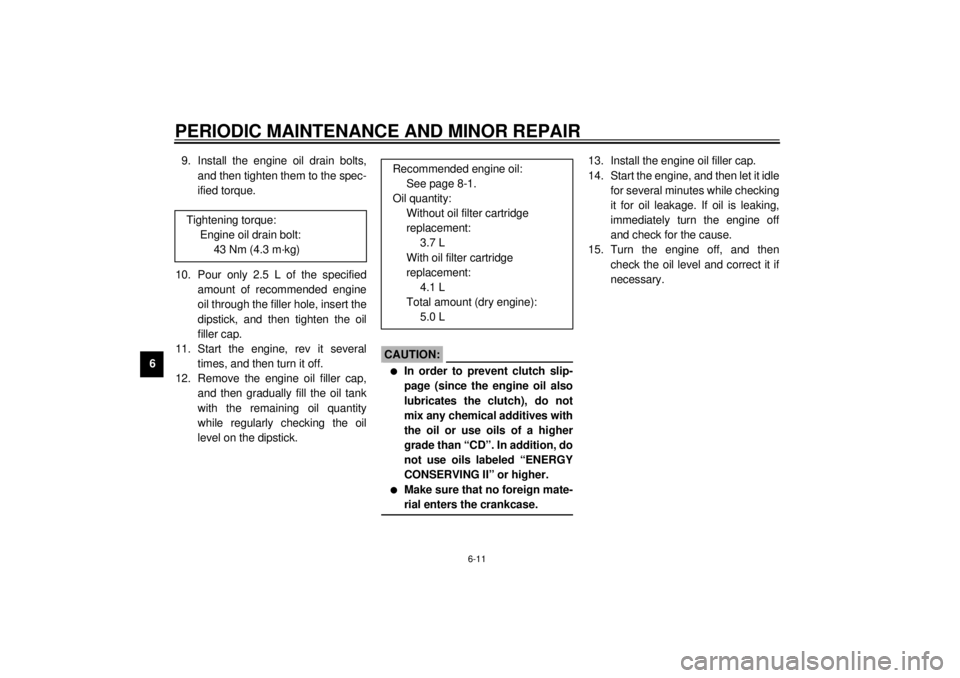
PERIODIC MAINTENANCE AND MINOR REPAIR
6-11
69. Install the engine oil drain bolts,
and then tighten them to the spec-
ified torque.
10. Pour only 2.5 L of the specified
amount of recommended engine
oil through the filler hole, insert the
dipstick, and then tighten the oil
filler cap.
11. Start the engine, rev it several
times, and then turn it off.
12. Remove the engine oil filler cap,
and then gradually fill the oil tank
with the remaining oil quantity
while regularly checking the oil
level on the dipstick.
EC000072
CAUTION:@ l
In order to prevent clutch slip-
page (since the engine oil also
lubricates the clutch), do not
mix any chemical additives with
the oil or use oils of a higher
grade than “CD”. In addition, do
not use oils labeled “ENERGY
CONSERVING II” or higher.
l
Make sure that no foreign mate-
rial enters the crankcase.
@
13. Install the engine oil filler cap.
14. Start the engine, and then let it idle
for several minutes while checking
it for oil leakage. If oil is leaking,
immediately turn the engine off
and check for the cause.
15. Turn the engine off, and then
check the oil level and correct it if
necessary. Tightening torque:
Engine oil drain bolt:
43 Nm (4.3 m·kg)
Recommended engine oil:
See page 8-1.
Oil quantity:
Without oil filter cartridge
replacement:
3.7 L
With oil filter cartridge
replacement:
4.1 L
Total amount (dry engine):
5.0 L
E_5JA.book Page 11 Wednesday, September 13, 2000 6:06 PM
Page 57 of 104
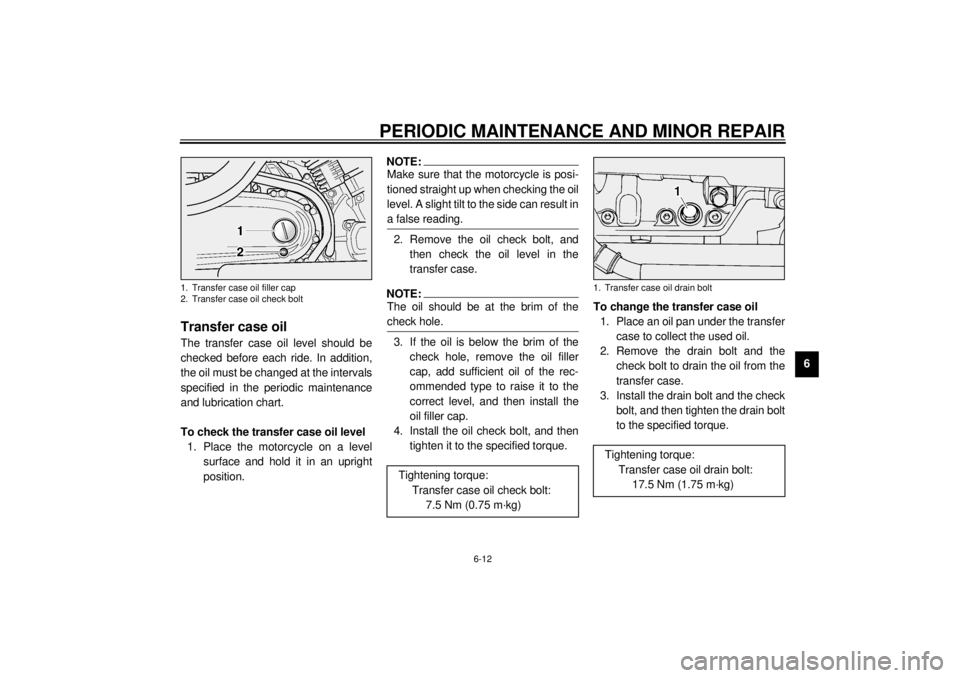
PERIODIC MAINTENANCE AND MINOR REPAIR
6-12
6
EAU03395
Transfer case oil The transfer case oil level should be
checked before each ride. In addition,
the oil must be changed at the intervals
specified in the periodic maintenance
and lubrication chart.
To check the transfer case oil level
1. Place the motorcycle on a level
surface and hold it in an upright
position.
NOTE:@ Make sure that the motorcycle is posi-
tioned straight up when checking the oil
level. A slight tilt to the side can result in
a false reading. @2. Remove the oil check bolt, and
then check the oil level in the
transfer case.NOTE:@ The oil should be at the brim of the
check hole. @3. If the oil is below the brim of the
check hole, remove the oil filler
cap, add sufficient oil of the rec-
ommended type to raise it to the
correct level, and then install the
oil filler cap.
4. Install the oil check bolt, and then
tighten it to the specified torque.To change the transfer case oil
1. Place an oil pan under the transfer
case to collect the used oil.
2. Remove the drain bolt and the
check bolt to drain the oil from the
transfer case.
3. Install the drain bolt and the check
bolt, and then tighten the drain bolt
to the specified torque.
1. Transfer case oil filler cap
2. Transfer case oil check bolt
Tightening torque:
Transfer case oil check bolt:
7.5 Nm (0.75 m·kg)
1. Transfer case oil drain boltTightening torque:
Transfer case oil drain bolt:
17.5 Nm (1.75 m·kg)
E_5JA.book Page 12 Wednesday, September 13, 2000 6:06 PM
Page 73 of 104
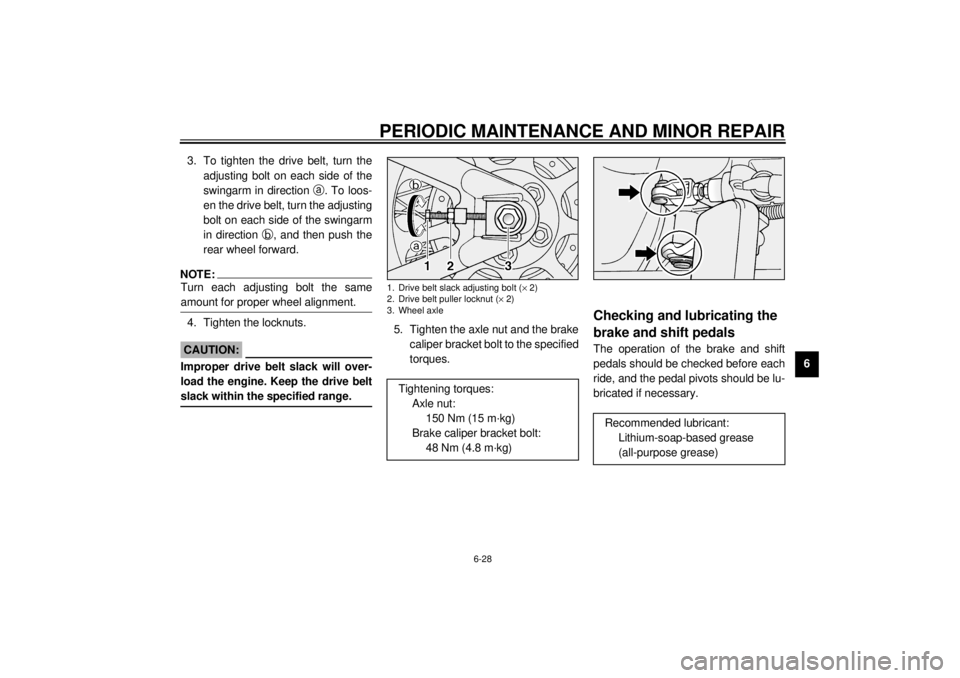
PERIODIC MAINTENANCE AND MINOR REPAIR
6-28
6 3. To tighten the drive belt, turn the
adjusting bolt on each side of the
swingarm in direction
a. To loos-
en the drive belt, turn the adjusting
bolt on each side of the swingarm
in direction
b, and then push the
rear wheel forward.
NOTE:@ Turn each adjusting bolt the same
amount for proper wheel alignment. @4. Tighten the locknuts.
ECA00025
CAUTION:@ Improper drive belt slack will over-
load the engine. Keep the drive belt
slack within the specified range. @
5. Tighten the axle nut and the brake
caliper bracket bolt to the specified
torques.
EAU03370
Checking and lubricating the
brake and shift pedals The operation of the brake and shift
pedals should be checked before each
ride, and the pedal pivots should be lu-
bricated if necessary.
1. Drive belt slack adjusting bolt (´ 2)
2. Drive belt puller locknut (´ 2)
3. Wheel axleTightening torques:
Axle nut:
150 Nm (15 m·kg)
Brake caliper bracket bolt:
48 Nm (4.8 m·kg)
Recommended lubricant:
Lithium-soap-based grease
(all-purpose grease)
E_5JA.book Page 28 Wednesday, September 13, 2000 6:06 PM
Page 96 of 104
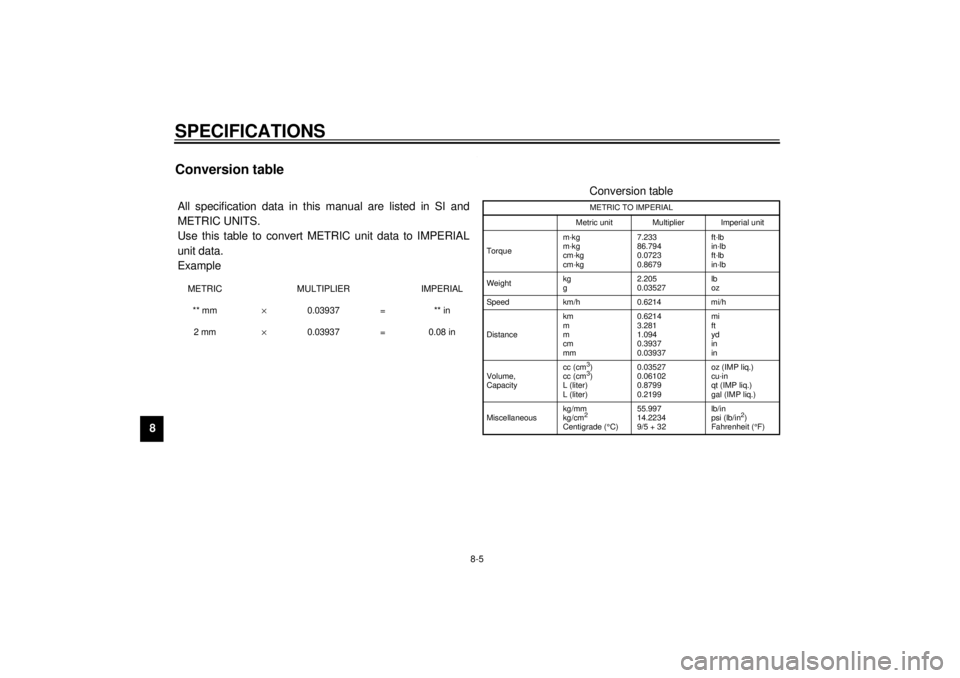
SPECIFICATIONS
8-5
8
EAU01064
Conversion table CS-02EAll specification data in this manual are listed in SI and
METRIC UNITS.
Use this table to convert METRIC unit data to IMPERIAL
unit data.
ExampleMETRIC MULTIPLIER IMPERIAL
** mm´ 0.03937 = ** in
2 mm´ 0.03937 = 0.08 in
Conversion tableMETRIC TO IMPERIAL
Metric unit Multiplier Imperial unit
Torquem·kg
m·kg
cm·kg
cm·kg7.233
86.794
0.0723
0.8679ft·lb
in·lb
ft·lb
in·lb
Weightkg
g2.205
0.03527lb
oz
Speed km/h 0.6214 mi/h
Distancekm
m
m
cm
mm0.6214
3.281
1.094
0.3937
0.03937mi
ft
yd
in
in
Volume,
Capacitycc (cm3)
cc (cm3)
L (liter)
L (liter)0.03527
0.06102
0.8799
0.2199oz (IMP liq.)
cu·in
qt (IMP liq.)
gal (IMP liq.)
Miscellaneouskg/mm
kg/cm2
Centigrade (°
C)55.997
14.2234
9/5 + 32 lb/in
psi (lb/in
2)
Fahrenheit (°
F)
E_5JA.book Page 5 Wednesday, September 13, 2000 6:06 PM